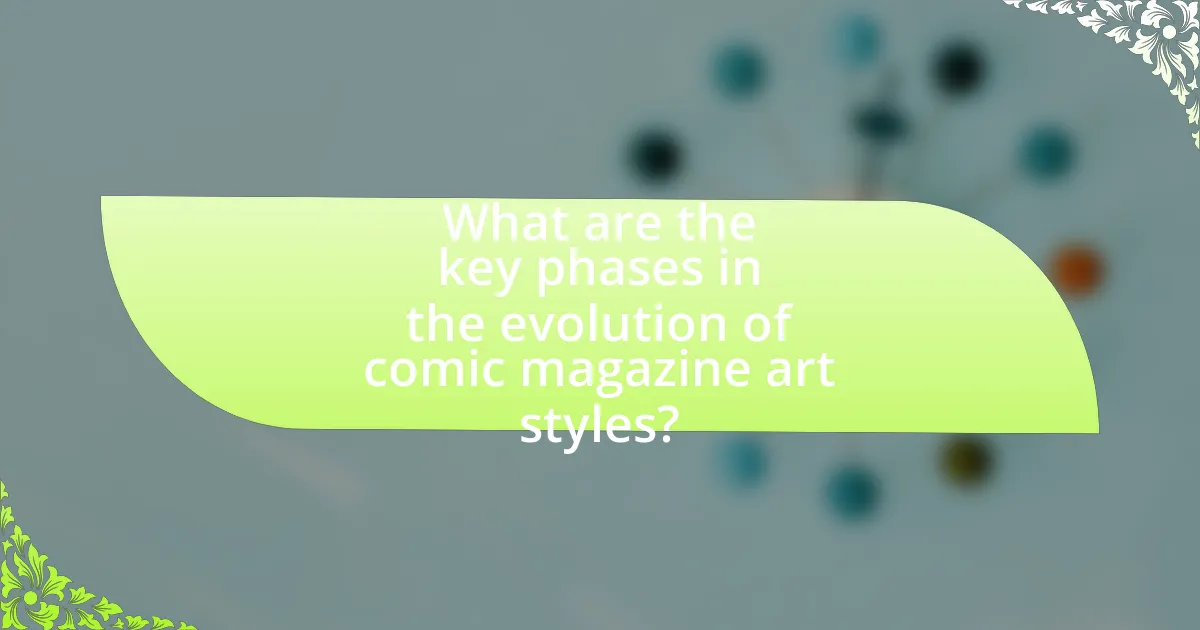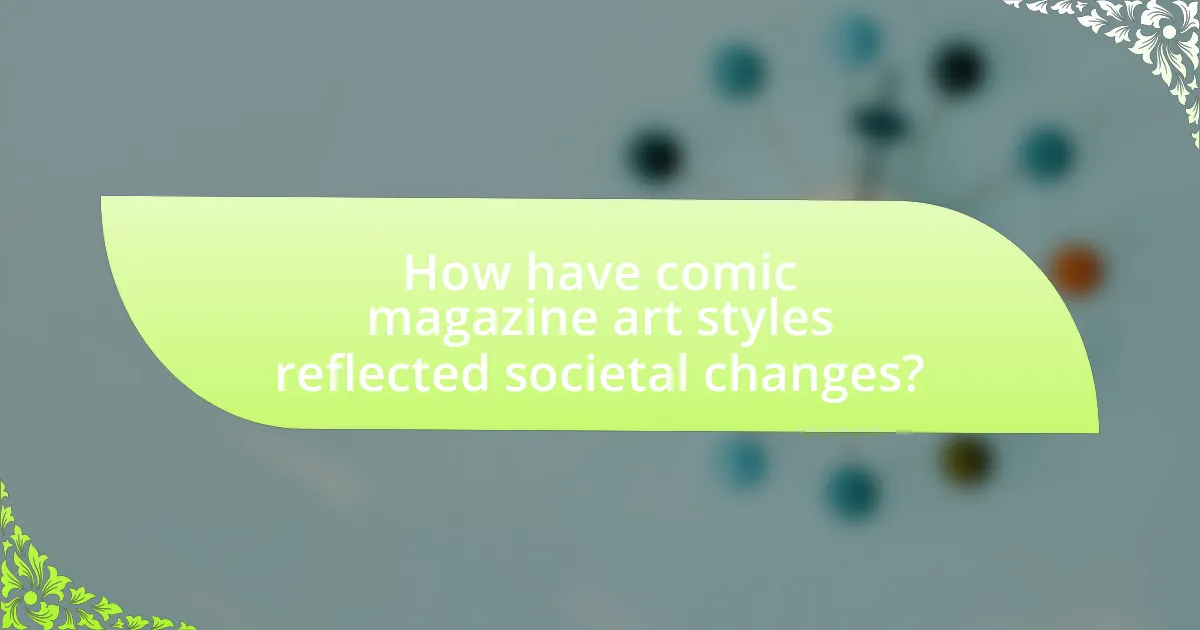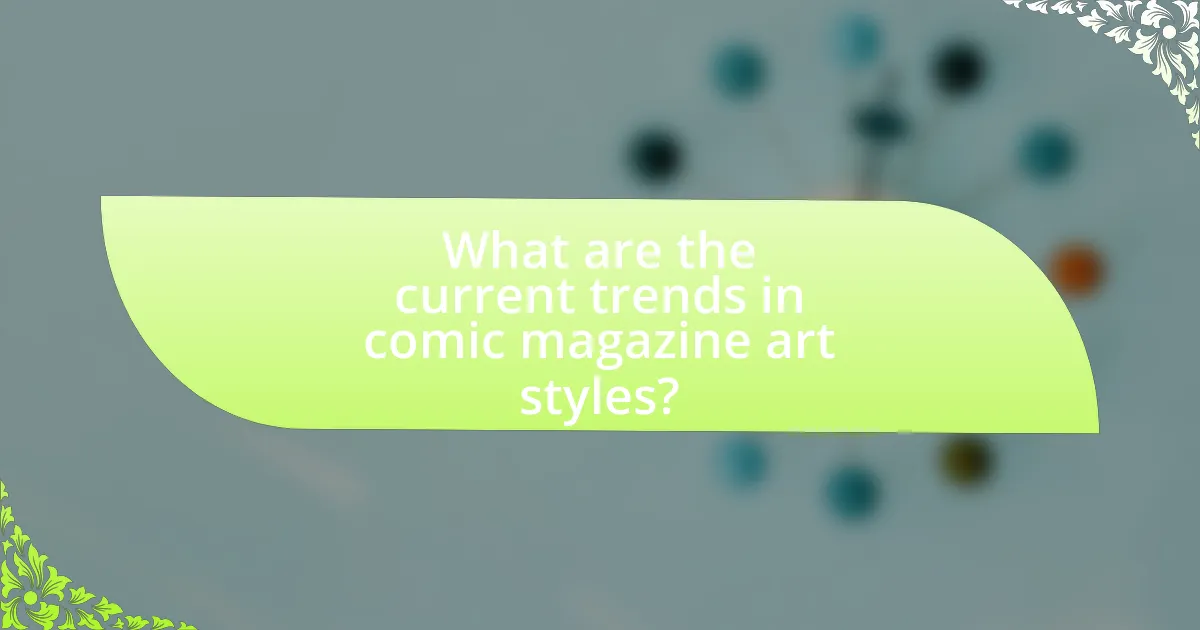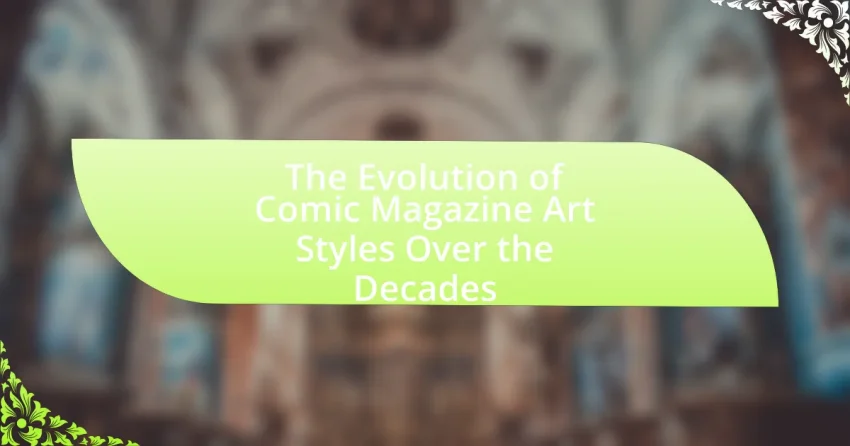The article examines the evolution of comic magazine art styles across four key phases: the Golden Age, Silver Age, Bronze Age, and Modern Age. It highlights how each era introduced distinct artistic techniques and narrative styles, reflecting cultural shifts and societal issues. The Golden Age established foundational visual elements, while the Silver Age saw more complex storytelling and character development. The Bronze Age incorporated darker themes, and the Modern Age emphasizes diverse styles and individual expression. Additionally, the article discusses the impact of technology, social movements, and demographic changes on comic art, illustrating how these factors have shaped contemporary trends and representations in the medium.

What are the key phases in the evolution of comic magazine art styles?
The key phases in the evolution of comic magazine art styles include the Golden Age, Silver Age, Bronze Age, and Modern Age. The Golden Age (1930s-1950s) introduced iconic characters and a simplistic, bold art style, exemplified by artists like Jerry Siegel and Joe Shuster with Superman. The Silver Age (1950s-1970s) saw a shift towards more complex narratives and a cleaner, more dynamic art style, with artists like Jack Kirby and Steve Ditko redefining superhero aesthetics. The Bronze Age (1970s-1980s) incorporated darker themes and more realistic art, influenced by social issues, as seen in works by artists like Neal Adams. The Modern Age (1980s-present) features diverse styles and storytelling techniques, with a focus on individual artist expression, as demonstrated by creators like Frank Miller and Alan Moore. Each phase reflects cultural shifts and advancements in artistic techniques, marking significant developments in comic magazine art.
How did the Golden Age of Comics influence art styles?
The Golden Age of Comics significantly influenced art styles by establishing foundational visual elements and narrative techniques that are still prevalent today. During this period, which spanned from the late 1930s to the early 1950s, artists like Jerry Siegel and Joe Shuster introduced bold colors, dynamic poses, and exaggerated features, which became hallmarks of comic art. The use of clear lines and vibrant palettes not only defined superhero comics but also inspired various artistic movements, including pop art in the 1960s. Furthermore, the storytelling techniques developed during this era, such as panel layouts and visual pacing, laid the groundwork for modern graphic novels and comic books, demonstrating the lasting impact of the Golden Age on contemporary art styles.
What artistic techniques were prominent during the Golden Age?
Prominent artistic techniques during the Golden Age of comic books included dynamic panel layouts, bold line work, and vibrant color palettes. These techniques were employed to enhance storytelling and engage readers visually. Dynamic panel layouts allowed for varied pacing and action sequences, while bold line work provided clarity and emphasis on characters and actions. The use of vibrant colors, often achieved through the four-color printing process, made comics visually appealing and accessible to a wide audience. These techniques collectively contributed to the distinctive style of Golden Age comics, which flourished from the late 1930s to the early 1950s.
How did storytelling impact the art style in this era?
Storytelling significantly influenced the art style in this era by prioritizing visual narratives that complemented character development and plot progression. Artists adapted their techniques to enhance emotional engagement, using dynamic compositions, expressive character designs, and varied panel layouts to convey action and mood effectively. For instance, the rise of graphic novels in the late 20th century showcased intricate illustrations that mirrored complex storytelling, as seen in works like “Maus” by Art Spiegelman, which combined detailed artwork with profound themes. This integration of storytelling and visual style not only enriched the reader’s experience but also established a new standard for artistic expression in comic magazines.
What changes occurred during the Silver Age of Comics?
The Silver Age of Comics, spanning from the late 1950s to the early 1970s, introduced significant changes in storytelling, character development, and artistic style. This era saw the emergence of more complex narratives and the introduction of flawed, relatable superheroes, such as Spider-Man and the X-Men, which reflected societal issues like prejudice and responsibility. Additionally, the art style evolved to feature brighter colors, dynamic layouts, and more detailed illustrations, largely influenced by artists like Jack Kirby and Steve Ditko. These changes revitalized the comic book industry, leading to increased readership and the establishment of comic conventions and fandoms, marking a pivotal shift in the cultural perception of comics.
How did the introduction of new genres affect art styles?
The introduction of new genres significantly transformed art styles by encouraging innovation and diversity in visual representation. For instance, the emergence of genres like horror and science fiction in comic magazines led to the development of unique artistic techniques, such as exaggerated forms and dynamic compositions, to convey heightened emotions and fantastical elements. Historical examples include the shift in the 1950s when horror comics utilized darker color palettes and more dramatic shading to evoke fear, contrasting with the bright, optimistic tones of superhero comics. This genre diversification not only expanded the thematic scope of comics but also influenced mainstream art movements, as artists began to adopt and adapt these new stylistic elements into their work, reflecting broader cultural shifts.
What role did cultural shifts play in the evolution of comic art?
Cultural shifts significantly influenced the evolution of comic art by reflecting societal values, norms, and issues of their respective eras. For instance, the Golden Age of comics in the 1930s and 1940s showcased superheroes like Superman and Batman, embodying ideals of heroism and patriotism during World War II. In contrast, the counterculture movement of the 1960s led to the emergence of underground comics, which challenged mainstream conventions and addressed topics such as sexuality, politics, and social justice. Additionally, the rise of graphic novels in the late 20th century, exemplified by works like Art Spiegelman’s “Maus,” highlighted the medium’s capacity for complex storytelling and serious themes, further evolving comic art as a legitimate form of literature. These cultural shifts not only shaped the content and style of comic art but also expanded its audience and critical reception, demonstrating the dynamic interplay between society and artistic expression.
What innovations characterized the Bronze and Modern Ages?
The Bronze Age of comics, spanning from the early 1970s to the mid-1980s, was characterized by innovations such as more complex storytelling, the introduction of anti-heroes, and a focus on social issues, reflecting the cultural changes of the time. Notable examples include the emergence of characters like Green Lantern/Green Arrow, which tackled topics like drug addiction and racism, showcasing a shift towards more mature themes in comic narratives.
In contrast, the Modern Age of comics, beginning in the mid-1980s and continuing to the present, introduced innovations such as the rise of independent publishers, the use of digital technology in art and distribution, and the expansion of graphic novels as a respected format. Key works like “Watchmen” and “The Dark Knight Returns” redefined the superhero genre, emphasizing darker tones and complex character development, which further influenced the evolution of comic art styles.
How did technology influence comic magazine art styles?
Technology significantly influenced comic magazine art styles by introducing new tools and techniques that enhanced artistic expression and production efficiency. The advent of digital art software, such as Adobe Photoshop and Illustrator, allowed artists to create more intricate and vibrant illustrations, moving away from traditional hand-drawn methods. Additionally, advancements in printing technology, including offset printing and digital printing, improved color reproduction and detail, enabling a broader range of artistic styles to be showcased. Historical shifts, such as the transition from black-and-white to full-color comics in the 1960s, were driven by these technological innovations, which expanded the visual possibilities for comic creators and attracted a wider audience.
What are the defining features of contemporary comic art?
Contemporary comic art is characterized by diverse visual styles, innovative storytelling techniques, and a focus on inclusivity. The diversity in visual styles ranges from traditional hand-drawn illustrations to digital art, reflecting various cultural influences and artistic movements. Innovative storytelling techniques include non-linear narratives and the integration of multimedia elements, such as animation and interactive components, which enhance reader engagement. Additionally, contemporary comic art emphasizes inclusivity by representing a broader range of voices and experiences, addressing social issues and diverse identities, as seen in works like “Ms. Marvel” and “The Walking Dead.” These features collectively illustrate the evolution of comic art, making it a dynamic and relevant medium in today’s cultural landscape.

How have comic magazine art styles reflected societal changes?
Comic magazine art styles have reflected societal changes by adapting visual narratives to align with cultural, political, and technological shifts. For instance, during the 1930s and 1940s, comic art often featured heroic figures and clear lines, mirroring the American idealism and patriotism prevalent during World War II. In contrast, the 1960s introduced more experimental styles and complex characters, reflecting the counterculture movement and social upheaval of that era. The rise of digital technology in the 1990s and 2000s led to a shift towards more vibrant colors and dynamic layouts, showcasing the influence of the internet and multimedia on storytelling. These transitions in art styles serve as a visual commentary on the evolving values, concerns, and aesthetics of society at different historical moments.
In what ways did art styles respond to political events?
Art styles in comic magazines have historically responded to political events by reflecting societal issues, influencing visual narratives, and shaping public perception. For instance, during World War II, comic art adopted a patriotic tone, with superheroes like Captain America symbolizing American values and rallying support for the war effort. This shift was evident in the use of bold colors and dynamic action scenes that conveyed heroism and national pride. Additionally, the civil rights movement in the 1960s prompted artists to address themes of social justice and equality, leading to more diverse representations and narratives that challenged the status quo. The incorporation of political satire in comics, such as those by artists like Gary Trudeau in “Doonesbury,” further illustrates how art styles adapt to critique and comment on contemporary political climates. These examples demonstrate that art styles in comic magazines not only mirror political events but also actively engage with and influence public discourse.
What examples illustrate the connection between art and politics in comics?
Comics often illustrate the connection between art and politics through works like “Maus” by Art Spiegelman, which depicts the Holocaust and critiques the impact of history on identity, and “V for Vendetta” by Alan Moore, which addresses themes of totalitarianism and individual freedom. These examples demonstrate how comics can serve as a medium for political commentary, using visual storytelling to engage with complex social issues. Additionally, “The Adventures of Obadiah Oldbuck” by Rodolphe Töpffer, considered one of the first comic strips, satirizes societal norms and politics of its time, showcasing the historical roots of political discourse in comics.
How did social movements influence comic art styles?
Social movements significantly influenced comic art styles by introducing themes of social justice, diversity, and political commentary. For instance, the civil rights movement in the 1960s led to the emergence of characters like Black Panther, who represented African American empowerment and challenged racial stereotypes. Additionally, feminist movements inspired the creation of strong female characters, such as Wonder Woman, who became symbols of female strength and independence. The LGBTQ+ rights movement also impacted comic art, with the inclusion of openly gay characters and storylines that addressed issues of identity and acceptance, as seen in titles like “Young Avengers.” These movements not only shaped the narratives within comics but also transformed the visual styles, incorporating more dynamic and expressive art to reflect the urgency and emotional weight of the social issues being addressed.
How have demographic shifts impacted comic magazine art styles?
Demographic shifts have significantly influenced comic magazine art styles by introducing diverse cultural perspectives and aesthetic preferences. As the readership expanded to include a broader range of ethnicities, genders, and age groups, artists began to incorporate varied visual elements and storytelling techniques that reflect these new audiences. For instance, the rise of female readership in the 1970s led to more nuanced female characters and art styles that emphasized empowerment and relatability, as seen in titles like “Ms. Marvel.” Additionally, the increasing representation of multicultural narratives has resulted in art styles that blend traditional techniques with contemporary influences, exemplified by works from creators like Gene Luen Yang, who merges Asian cultural motifs with modern comic aesthetics. This evolution illustrates how demographic changes have not only diversified the themes and characters in comics but also transformed the visual language of the medium itself.
What trends emerged in art styles as audiences diversified?
As audiences diversified, trends in art styles included the incorporation of multicultural influences, a shift towards more inclusive representation, and the blending of various artistic techniques. This evolution reflected the growing demand for narratives that resonated with a broader demographic, leading to the emergence of styles that embraced diverse cultural aesthetics and storytelling methods. For instance, the rise of independent comics in the late 20th century showcased voices from underrepresented communities, resulting in unique visual styles that combined traditional and contemporary elements. This shift was evident in works by creators such as Gene Luen Yang and Marjorie Liu, who integrated their cultural backgrounds into their art, thereby enriching the comic landscape and appealing to a wider audience.
How have gender representations evolved in comic art?
Gender representations in comic art have evolved from predominantly hypersexualized and stereotypical portrayals to more diverse and nuanced depictions. In the early 20th century, female characters were often depicted as damsels in distress or overly sexualized figures, reflecting societal norms of the time. For instance, characters like Wonder Woman, introduced in 1941, began to challenge these stereotypes by presenting a strong female figure, yet still retained some elements of objectification.
By the late 20th century, the rise of independent comics and graphic novels introduced a wider range of female characters, showcasing complex personalities and roles beyond traditional gender norms. Works such as “Persepolis” by Marjane Satrapi and “Fun Home” by Alison Bechdel highlighted women’s experiences and identities in more authentic ways.
In recent years, the representation of gender in comics has further diversified, with an emphasis on intersectionality and inclusivity. Characters now reflect a broader spectrum of gender identities and sexual orientations, as seen in titles like “The Wicked + The Divine” and “Ms. Marvel,” which feature protagonists from various backgrounds and experiences. This shift indicates a growing recognition of the importance of representation in media, aligning with contemporary discussions around gender and identity.

What are the current trends in comic magazine art styles?
Current trends in comic magazine art styles include a blend of digital techniques, diverse representation, and a focus on minimalist aesthetics. Digital art has become predominant, allowing for vibrant colors and intricate details that were previously difficult to achieve. Additionally, there is an increasing emphasis on inclusivity, with artists from various backgrounds contributing unique cultural perspectives, which enriches storytelling and visual representation. Minimalist styles are also gaining traction, characterized by clean lines and simplified forms, which resonate with contemporary audiences seeking clarity and directness in visual narratives. These trends reflect the evolving tastes and values of readers in the comic book industry.
What styles are gaining popularity in today’s comic magazines?
Contemporary comic magazines are increasingly showcasing styles such as minimalist art, retro aesthetics, and diverse representation. Minimalist art, characterized by clean lines and simplified forms, appeals to modern audiences seeking clarity and focus in storytelling. Retro aesthetics draw inspiration from classic comic styles, often incorporating vibrant colors and nostalgic themes, which resonate with both older and younger readers. Additionally, the emphasis on diverse representation in characters and narratives reflects a broader cultural shift towards inclusivity, making comics more relatable to a wider audience. This trend is supported by the rise of independent publishers and webcomics, which prioritize unique artistic expressions and diverse voices.
How are independent artists shaping the future of comic art?
Independent artists are shaping the future of comic art by introducing diverse narratives and innovative styles that challenge traditional norms. Their ability to self-publish and utilize digital platforms allows for greater creative freedom, enabling them to explore themes often overlooked by mainstream publishers. For instance, the rise of webcomics has democratized access to comic creation, allowing artists like Sarah Andersen and Randall Munroe to gain significant followings and influence the medium. This shift not only diversifies the types of stories told but also expands the audience for comic art, as independent creators often cater to niche markets and underrepresented voices.
What role does digital art play in modern comic magazine styles?
Digital art plays a crucial role in modern comic magazine styles by enabling artists to create more dynamic and visually complex illustrations. This technology allows for enhanced color palettes, intricate details, and the ability to easily manipulate images, which contributes to a more polished and professional final product. For instance, tools like Adobe Photoshop and Procreate have revolutionized the workflow of comic artists, allowing for faster production times and the integration of multimedia elements. Additionally, digital platforms facilitate the distribution of comics, reaching wider audiences through webcomics and digital publishing, which has become increasingly popular in the 21st century.
How can aspiring artists adapt to current trends in comic art?
Aspiring artists can adapt to current trends in comic art by studying popular styles and techniques used by successful contemporary artists. This involves analyzing current bestsellers and online platforms like Webtoon and Tapas, which showcase trending art styles and storytelling methods. For instance, the rise of digital art tools has influenced many artists to incorporate vibrant colors and dynamic compositions, reflecting the preferences of modern audiences. Additionally, participating in online communities and social media platforms allows artists to receive feedback and stay updated on emerging trends, ensuring their work resonates with current readers.
What techniques should new artists focus on to stay relevant?
New artists should focus on digital illustration techniques, social media engagement, and understanding current trends to stay relevant. Digital illustration allows for versatility and accessibility, enabling artists to create and share their work efficiently. Social media platforms like Instagram and TikTok provide avenues for artists to showcase their art, connect with audiences, and participate in viral trends, which can significantly increase visibility. Additionally, staying informed about current trends in comic art styles, such as the integration of diverse narratives and experimental formats, helps artists align their work with audience preferences. According to a 2021 survey by the Comic Book Legal Defense Fund, 70% of comic readers prefer stories that reflect diverse experiences, highlighting the importance of relevance in content creation.
How can artists balance personal style with market demands?
Artists can balance personal style with market demands by integrating their unique artistic voice into commercially viable projects. This approach allows artists to maintain authenticity while appealing to audience preferences. For instance, successful comic artists often adapt their styles to fit popular trends without losing their signature elements, as seen in the works of creators like Jim Lee, who blends personal flair with mainstream appeal. Market research indicates that artists who engage with their audience through social media can better understand market trends, enabling them to tailor their work accordingly while preserving their individuality.
